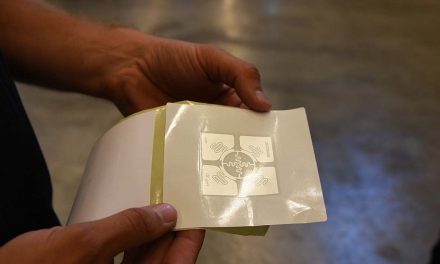
Maximising the return at the doorstep
Mobile Data Capture for Postal Operators
World Mail Review November 2008 INTRODUCTION
All companies are faced with the twin challenges of improving customer service and reducing costs. Posts are not immune, but these generic challenges are compounded by a whole range of threats and opportunities arising from market liberalisation and the development of the Internet.
The use of technology to provide more timely, cost effective, information is one important strategic response. The deployment of mobile data capture technologies is increasingly understood by posts as a key component in this approach. In particular, mobile data capture supports and enhances the key defensible competitive strength of many posts – their ability to deliver to every address in a way no other type of operator can, their dominance of ‘the last mile’.
FROM EXPRESS PARCELS TO INTELLIGENT LETTERS
The belief that ‘information is as important as the package’ has been a mantra of the global express industry for over a quarter of a century. The use of a bar code to track an item through certain key processes from point of collection to point of delivery has been long established. However, the speed with which that information can be accessed, particularly by the shipper, has changed dramatically. Today, the deployment of mobile data capture devices by the courier, together with the use of the internet, has made that information available to the shipper in real time, on demand.
There has also been a natural extension in the use of track and trace and proof of delivery. In the 1990’s it moved from relatively expensive ‘next day’ express shipments into later than next day business parcels. Posts themselves adopted track and trace for their value added letter services, such as guaranteed next day. But there was a perceived barrier in that track and trace was felt to be not appropriate for regular mail services–letters and non-express small packages to consumer addresses. That barrier is breaking down under the pressure of fundamental market changes. As in express in the l980’s, information is becoming an ever more important component of the delivery experience, irrespective of the type of item being delivered. ‘Intelligent Mail’ has arrived.
THE INCREASING CUSTOMER DEMAND FOR INFORMATION
Whilst the increase in direct competition to posts is undoubtedly a factor in encouraging posts to provide more information, arguably a far more significant competitive threat is the change in the communications mix with the growth of internet advertising, e mail, SMS and text messaging and the like. In this environment posts are looking to add value to the use of physical mail over other communications means. One way of adding value is to offer more information on the progress of the mail piece, thus assisting better response planning for payment receipt offices, and call centres, for example.
And then there is e-commerce. The rise of e-commerce is a great opportunity for posts. Whilst competitors (or posts own parcel subsidiaries) have taken huge shares in the B2B market, posts have in many countries held on to their unique ability to deliver to every consumer address every day.
Major e-commerce shippers require a reliable home delivery service combined with the ability for the recipient to designate an address other than their home for delivery, and a simple returns system. Posts have the infrastructure to offer these services, providing they can also provide data on where the shipment is, and particularly proof of delivery, in real time and a cost effective manner.
Smaller e-commerce shippers (eg many sellers on eBay) are themselves private individuals or operating as small businesses from their home addresses. They too look to the posts as the natural partner to help in the posting of the package as well as the delivery. And they too want the assurance that comes from tracking information, particularly proof of delivery.
For the doorstep recipient the benefits include pre-alert of delivery status (via SMS); greater flexibility in delivery timing and location; greater confidence that deliveries will be made to the right address (thanks to GPS); a simple digital signature process; and instant registration of damage via mobile photography. These benefits add up to a much improved perception of postal quality.
This changing environment demands that posts provide more real time information on shipments to their customers, even for what have traditionally been regarded as ‘low value’ items. Without this capability posts will lose existing business and miss out on the continued growth of e-commerce. This places the adoption of mobile data capture technology at the heart of the new competitive positioning for posts.
TECHNICAL OVERVIEW: HOW MOBILE DATA CAPTURE WORKS
Hand held mobile devices can incorporate all the attributes of a computer, mobile phone, and personal digital assistant, and can include a laser scanner, imager, and global positioning system.
The scanner may have 1D (horizontal) bar code read capability, or 2D (horizontal and vertical), or RFID. Each of these offers the prospect of providing progressively more data, although in practice RFID is not yet appropriate for doorstep applications.
For Proof of Delivery (POD) older systems relied on peeling the bar code off the item at point of delivery, placing it in a book, and asking the recipient to sign for delivery opposite the bar code. The delivery information could only be downloaded once the driver returned to the depot. In modern systems this has been replaced by a digital signature which supports real time POD information.
Image capture can be used to demonstrate a delivery attempt if the consignee was not at home, or to record any damage to the items being delivered.
The mobile device provides the optimum method for communicating with the host system using wireless technology, whether through wide, local or personal networks, or voice over the internet. In conjunction with global positioning information this mix of connectivity enables flexible, cost effective, voice and data communications both inside buildings and beyond. With the addition of General Packet Radio Service it is also cost effective to have the mobile device switched on at all times, since the user is only charged for the data transmitted rather than the time connected.
The result is not only real time information on the delivery process, but also other information that can be used to improve decision making and operational efficiency.
OTHER BENEFITS OF USING MOBILE DATA CAPTURE
As well as the competitive benefits arising from better data capture at the delivery doorstep, investment in mobile data capture technology can result in a much wider range of benefits for posts. Here are a couple of examples:
REVENUE ENHANCEMENT
The addition of on the ground data capture capability to the ubiquitous delivery network reaching every household and business, combined with the local knowledge of the delivery person, provides an opportunity to move into a whole range of doorstep services which would otherwise be difficult to undertake cost effectively.
Examples of revenue enhancing services under consideration by posts include: payment collection on delivery; collection of return items, a key focus for e-commerce; collection of legal or certified documents; doorstep sales e.g. stamps, simple financial services; and meter reading for utilities e.g. water, gas, electricity. Wider services could include acting as an environmental watchdog, reporting water leaks, damage or vandalism to infrastructure etc; and community services such as checking on the elderly or vulnerable, or delivering prescription drugs requiring signature as proof of delivery.
EFFICIENCY AND PRODUCTIVITY IMPROVEMENTS
Data can be captured at every point of activity: at collection, in the transit depots, on the road, at the hub, on delivery. This can be used to evaluate efficiency and productivity and highlight areas for improvement.
Real time wireless communications enable automatic transmission of load details to operations control after each collection. It also allows the progress of the vehicles back to base so that labour can be more efficiently assigned. Improved visibility of traffic flow through the networks allows operators to improve capacity planning and handling at peak periods. Analysis of data, particularly from GPS systems, can help route optimisation, and reduce fuel and other vehicle costs, which also supports the environmental agenda. Vehicles can be diverted en route at minimal cost if new activities are required.
Electronic scanning of signatures and real time wireless transmission of information reduces the time at delivery and can in effect increase the delivery day. As the final mile accounts for such a significant proportion of postal costs, even a small improvement in efficiency can result in very real cost reductions.
The use of a single multifunction device minimises IT complexity and the need to support multiple applications for mobile computers, cell phones etc.
Overall, posts are able to reduce administration, labour, and associated costs. The effective elimination of manual intervention in capturing and transmitting data also diminishes the risk of errors and the costs of associated re-work.
THE FUTURE FOR MOBILE DATA CAPTURE
There are a number of developments on the horizon, including lighter weight devices; the synchronisation and convergence of voice and data; and using 3G radio to provide better quality images and data streaming. Broadband speed will enable more complex and detailed imaging, and readers that can process credit and debit card transactions are in development.
The single most transformational development is likely to be the widespread introduction of Radio Frequency Identifier (RFID) tags. The technology is well established and the cost of the technology is rapidly reducing. At some point in the next decade it will become cost effective to deploy on a wide scale in posts. Indeed, in due course the postal market is expected to be the second largest application for RFID, after the retail supply chain.
RFID tags offer a number of advantages over more conventional barcodes. They do not require line of sight to be read, and can typically be read over a much greater range. Tags can contain larger amounts of data, which, unlike bar codes, can be changed after the event.
ACKNOWLEDGEMENTS
This article is a brief summary of a 20 page White Paper prepared by Triangle Management Services earlier this year, and sponsored by Motorola. If you would like to receive the full White Paper, as well as more information on Motorola mobility solutions, contact the Motorola call centre on +44 (0) 1256 790998 (Europe) or 0800 028 7787 (UK), or contact [email protected].












